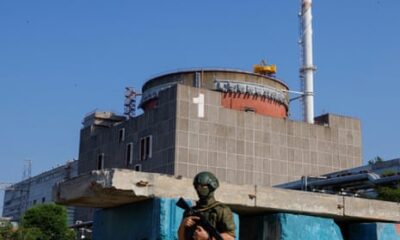Business
Russia Intensifies Drone Strikes on Ukraine After Zelenskyy’s Talks

Russia escalated its military actions against Ukraine on August 19, 2023, launching an extensive air assault that included 270 drones and 10 missiles. This aggressive response followed Ukrainian President Volodymyr Zelenskyy’s recent discussions with US President Donald Trump and European leaders, which aimed to bolster support for Ukraine amid the ongoing conflict.
Ukrainian officials reported that the sustained bombardment resulted in the deaths of 15 individuals and left at least 76 injured across various regions, including Kharkiv, Donetsk, Zaporizhzhya, and Kherson. The Poltava region experienced significant impacts, with over 1,500 residents losing access to electricity due to the strikes. In Chernihiv, drone attacks caused damage to infrastructure, disrupting power supplies further. Reports indicated that a Ukrainian drone strike later that day targeted areas in the Zaporizhzhya region under Russian control, leading to power outages, as confirmed by Moscow-installed Governor Yevgeny Balitsky on Telegram. Restoration efforts faced challenges due to ongoing threats of further strikes and darkness.
The intensity of the Russian attacks has sparked a strong condemnation from Ukrainian Foreign Minister Andriy Sybiha, who described them as “the opposite of peace” while diplomatic efforts continued in Washington. Local residents in Kyiv expressed skepticism about the effectiveness of these diplomatic initiatives, with one woman stating, “After they rolled a red carpet for [Russian President Vladimir Putin], I completely lost my faith in humanity.” Another resident voiced concerns about the possibility of Zelenskyy meeting with Putin, whom she referred to as a “monster.”
Despite the apprehensions, the discussions in Washington concluded with Trump indicating a commitment to bring Putin to the negotiating table. Zelenskyy has consistently expressed his readiness for talks, while Putin has not reciprocated. Following the meetings, a Kremlin statement suggested potential high-level contacts between Moscow and Kyiv but notably did not mention the two leaders explicitly. Russian Foreign Minister Sergei Lavrov remarked on August 19 that “any contacts involving the most senior leaders need to be prepared with the utmost care.”
European leaders remain doubtful about Putin’s willingness to engage without significant pressure from the United States. In Washington, German Chancellor Friedrich Merz commented, “We don’t know whether the Russian president will have the courage to attend such a summit. Therefore, persuasion is needed.” Meanwhile, Trump maintained that Putin had agreed to meet Zelenskyy, although he acknowledged that it might not lead to a resolution.
The recent surge in Russian strikes has further exacerbated the humanitarian crisis in Ukraine. The attacks have consistently targeted civilian areas, resulting in widespread destruction of homes, schools, hospitals, and energy infrastructure. While Russia denies intentionally targeting nonmilitary sites, the evidence suggests otherwise, with significant civilian casualties.
During the Washington discussions, security guarantees for Ukraine emerged as a critical topic, with Zelenskyy indicating that a proposed $90 billion program for purchasing US weapons was on the table. Although US and European leaders discussed these guarantees, specific details remain unclear amidst the ongoing conflict.
As hostilities continue, Ukraine’s General Staff reported on August 19 that 186 combat engagements occurred within a 24-hour period. Russian forces launched two missile strikes and conducted 78 air strikes, dropping 162 guided bombs. The most intense fighting is concentrated near the town of Pokrovsk in the Donetsk region.
The UN Human Rights Monitoring Mission in Ukraine has issued a stark warning about the impact of intensified Russian assaults on civilians. According to their report, 286 civilians were killed and 1,388 injured in July alone, marking the highest monthly casualty figures since May 2022. The mission attributed this rise in casualties primarily to increased aerial bomb usage and short-range drone attacks.
Danielle Bell, head of the UN Human Rights Monitoring Mission, emphasized the dire situation facing civilians: “Whether you are in a hospital or a prison, at home or at work, close to or far away from the front line, if you are in Ukraine today, you are at risk of getting killed or injured by the war.” She noted that the risk to civilians has significantly increased compared to the previous year and continues to rise, highlighting the urgent need for effective diplomatic solutions to end the violence.
-

 Entertainment2 months ago
Entertainment2 months agoAnn Ming Reflects on ITV’s ‘I Fought the Law’ Drama
-

 Entertainment3 months ago
Entertainment3 months agoKate Garraway Sells £2 Million Home Amid Financial Struggles
-

 Health2 months ago
Health2 months agoKatie Price Faces New Health Concerns After Cancer Symptoms Resurface
-

 Entertainment2 months ago
Entertainment2 months agoCoronation Street’s Carl Webster Faces Trouble with New Affairs
-

 Entertainment2 months ago
Entertainment2 months agoWhere is Tinder Swindler Simon Leviev? Latest Updates Revealed
-

 Entertainment3 months ago
Entertainment3 months agoKim Cattrall Posts Cryptic Message After HBO’s Sequel Cancellation
-

 Entertainment2 months ago
Entertainment2 months agoOlivia Attwood Opens Up About Fallout with Former Best Friend
-

 Entertainment2 months ago
Entertainment2 months agoMasterChef Faces Turmoil as Tom Kerridge Withdraws from Hosting Role
-

 Entertainment3 months ago
Entertainment3 months agoSpeculation Surrounds Home and Away as Cast Departures Mount
-

 World2 months ago
World2 months agoCole Palmer’s Mysterious Message to Kobbie Mainoo Sparks Speculation
-

 Entertainment3 months ago
Entertainment3 months agoMarkiplier Addresses AI Controversy During Livestream Response
-

 Entertainment2 months ago
Entertainment2 months agoITV’s I Fought the Law: Unraveling the True Story Behind the Drama





















